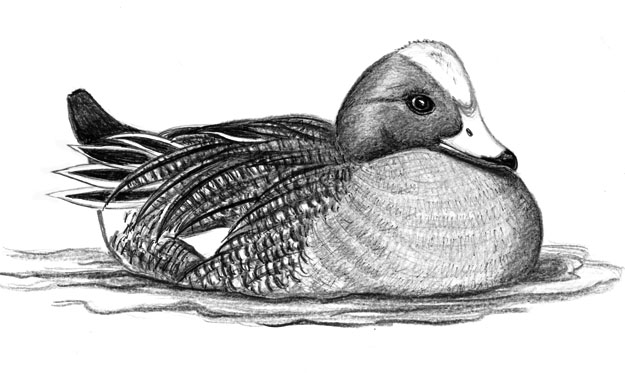
Dear Bird Folks,
For the past few winters I have seen a single Eurasian Wigeon swimming on Mill Pond in Marstons Mills. I’ve also heard these birds are being seen in other parts of the Cape. Is the Eurasian Wigeon moving over here from Europe? Do you think it will become a problem like the European Starlings have?
– Lou, Mashpee, MA
Hold on Lou,
You aren’t the Lou from TV are you? Please tell me your aren’t that Lou Dobbs guy who is obsessed with illegal immigrants? Do we have to build a fence around Marstons Mills to keep out foreign ducks? Personally, I think the fence thing is a good idea, but not for ducks. I know several people from Marstons Mills and sometimes I wish they’d build a fence to keep those people from bothering the rest of us. They know who they are.
As the name indicates, Eurasian Wigeons are from the Old World. (In this case, the Old World refers to Europe, Africa and Asia, not Chatham.) Wigeons are medium-sized ducks with two distinct species, the Eurasian and the American Wigeon. The male Eurasian Wigeon is a handsome bird. Its key field mark is a cinnamon-colored head, with a buff-colored streak in the middle, which gives him a stylish, trendy look. On this side of the Atlantic (the New World) we have the more ordinary-looking American Wigeon. The drake features a partially green head, with a large white patch running down the center. However, rather than looking trendy, he looks more like a mallard that needs to have its roots touched up.
Eurasian Wigeons are a widespread species that breeds throughout the aforementioned Old World. But that’s not enough room for them. Each fall a handful of these birds go looking for greener pastures. A small, but consistent number of Eurasian Wigeons leave Europe and somehow find their way to North America. How do they get here? They fly, of course. Thousands of miles of open ocean may keep our chickadees and cardinals from visiting England or prevent their weird little robin and other songbirds from coming over here, but a water barrier is not a problem for ducks. It is thought that most of the long-range migrants leave from Iceland, find their way to Canada and then spread down the Atlantic coast. At that point they are liable to popup just about anywhere, even Marstons Mills.
Anyone interested in seeing a Eurasian Wigeon should first look for a flock of American Wigeons since the foreign birds seem to gravitate toward their American cousins. One reason for the close association is that both birds have the same feeding habits and dietary needs. If a pond can support a large flock of American Wigeons, it should be more than adequate to sustain a wandering Eurasian Wigeon as well. There is also another theory. Some believe the drake Eurasian Wigeon hangs out with his ugly American cousins to make himself look better…just like single men going to bars and clubs with their homely friends, which makes them look better by comparison. Hmm. No wonder I’m always being invited out.
There’s an interesting side note about these traveling Eurasian Wigeons; nearly all of them seem to be drakes. The reason for this exclusion isn’t clear. One thought is that female Eurasian Wigeons, which look nearly identical to American Wigeon hens, are too difficult to indentify and are often overlooked by birders. Another theory is that the male birds occasionally get disoriented during migration and end up over here because they are just too stubborn to ask for directions. The females, on the other hand, are used to getting lost have no problem asking for directions.
Often when an unusual duck visits our area it inevitably is found in an out-of-the-way location. Seeing such a bird frequently includes a long walk on a cold beach or bushwhacking through briars and poison ivy to access a secluded pond. More than once I’ve had to cut through a private yard to get to pond that has no public access. (Try explaining that to a cop. “Sorry I was trespassing Officer, but I wanted to check out a pretty duck.”) Fortunately, the Mill Pond in Marstons Mills is anything but secluded. It sits at the junction of Routes 28 and 149, one of the busiest intersections on the Cape. Yet, even with all the trucks, buses and passing cars, it is a surprisingly good pond for seeing ducks. And unlike larger ponds where ducks often hide in a dark, distant corner, this pond is small so the ducks can be seen with little effort. Heck, the birding is so easy you don’t have to get out of your car (but remember to pull off the road). The day I spotted a Eurasian Wigeon on that pond I was driving to an appointment. I got so excited that I jammed on my brakes and forgot about the traffic behind me. There was a cement truck driver who wasn’t as excited about seeing a Eurasian Wigeon as I think he should have been.
It’s been nearly 100 years since birders first noticed Eurasian Wigeons in Massachusetts, Lou. In all that time there is no evidence that they have ever nested here. They are winter visitors only and aren’t likely to become the problem that starlings or other introduced species have. There’s no need to be concerned about them taking over Marstons Mills. They only thing you have to worry about is stopping short in front of one particular cement truck driver. I don’t think he’s calmed down yet.